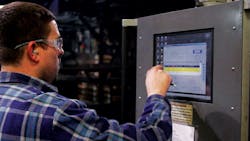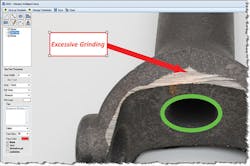One of the biggest challenges in implementing Shop Floor Data Collection (SFDC) is simply to know where to start. Many people remember the “old days” (circa 2010) when implementing SFDC system was a drawn-out series of technical decisions involving, of course, high costs. But things have changed since then, and most metalcasters will benefit from a simple process that will help create an effective shop floor data collection strategy.
Paper is still the most common form of SFDC for metalcasters. Why? When it comes to Enterprise Resource Planning (ERP) systems, most metalcasters focus on the front office. The shop floor, where profits are generated, is deemed impractical to collect this information. Instead, a blizzard of paper is generated, written on, lost, found, and eventually handed to the front office for manual entry into the ERP system or spreadsheet. Of course, the information in that blizzard is often illegible and/or wrong, as well as too late to be really useful.
But, the shop floor is a fantastic opportunity to save time and money by leveraging your ERP investment. Every keystroke saved, every piece of paper eliminated will increase your organization’s productivity and accuracy. Imagine gaining the knowledge of your inventory and your costs while reducing quality issues before they happen.
Where to start — First, review the information you are currently collecting from the shop floor. During the review, ask yourself two questions: Is collecting this bit of information necessary to your success (note that many organizations collect information that goes nowhere)? And, what additional information do you need to collect? This step should include the various spreadsheets tracking information beyond the scope of generic production, quantity, time, and scrap reporting.
Second, determine what type of information your employees need to perform their jobs successfully. In the old days, work instructions were printed on a sheet of paper and added to the paper blizzard. Now, SFDC systems present the opportunity to gain agility and go “paperless.” Ask your employees what they need to produce quality castings on-time. Images? CAD drawings? CAR information? Internet access for customer instructions? Or maybe the ability to annotate images or change work instructions as production occurs? All these are easy to do with the correct SFDC system. Ask these questions and explore where you can gain agility and eliminate waste.
Shop Floor Data Collection with Data Validation
Third, identify the most error-prone procedures. Nothing is more frustrating than inaccurate data. Make sure the SFDC has built-in entry data validation (e.g., order number, part number, step, quantity, etc.) to ensure accurate reporting, and review whether other reporting activities (e.g., calculating time worked on a job) can be collected without further effort for the operator. Even better, ensure your SFCD can download production information directly from shop floor equipment.
Fourth, determine where you can collect the “current” information and the “additional information.” Objectively evaluate your shop personnel to determine what specific requirements they have (e.g., non-English speaking operators) when interacting with a SFDC system. We have found most equipment operators have the required skill set to input data; they simply lack the correct technology.
Fifth, review the types of devices you can use in the key data collection areas. We have seen everything from a 40-in. LCD hooked up to a PC to hardened shop-floor devices, to iPads and other portable devices. Walk the shop floor and determine what types of devices are needed and the best placement for them to improve efficiency. Remember, the further someone has to walk to input and review information, the greater is the chance they will be delayed or distracted before they complete the task.
Sixth, question everything. Question your current or potential SFDC software and ensure not only that the software meets your current requirements but also your future requirements, without the need for costly programming modifications and/or hardware upgrades. Simple details like adding functions, instructions or even color-coding buttons should be an easy, cost-effective (even free) process. Much has changed over the past five years, and the shop-floor revolution will continue.
Map it out, make it fit — Now you can map out the project. Unless your shop floor has experience in data collection, we recommend starting the project in one department. Once it’s established, review other areas for potential ROI including: maintenance, shipping, finishing, melting, quality, and even material inventory transactions. There are many SFDC solutions in the marketplace. Criteria to look for include:
• Integration: Is the SFDC solution integrated with the ERP system? Does the scheduling module interact with the SFDC? Does the quality information including work instructions, images and videos, which update the SFDC instantly? Or is there lag time? This is critical to ensuring the proper edits are in place so that accurate information is presented and recorded.
• Two-way communication: Does the SFDC only collect information, or can it also display information like work instructions, images, videos, PDFs, etc.? The need for information is accelerating; paper just won’t cut it anymore!
• Flexible: Is the proposed solution flexible enough to change as your and your customers’ requirements change? Custom programming is a short-term fix that will become expensive or will lock you in at a release level.
Remember, this is not a technical decision or process. First and foremost, this is a business decision. Your goal should be to collect the data you need, efficiently and accurately, while making quality castings on time.
Matt Gacek is vice president - business development for B&L Information Systems. Contact him at [email protected], or visit www.blinfo.com
About the Author
Matt Gacek
Professional Services Project Consultant
Matt Gacek is a Project Consultant in the Professional Services Department for B&L Information Systems. Contact him at [email protected], or visit www.blinfo.com

